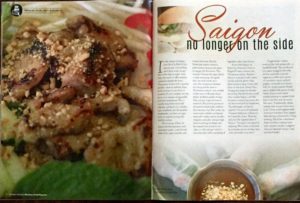![]() May/June 2015
May/June 2015
 In the streets of Saigon, now Ho Chi Minh City, one can eat a nourishing meal from a cart at any time of the day or night. And often the meal on offer remains consistent despite the hour. Vietnamese food is full of garden goodies, meat or seafood, bone broth and rice in one form or another. It’s not complex, but the joy is in its simple, recognizable, and raw components. Pho, a noodle soup with unlimited add-ins, and banh mi, a tender, tasty sandwich, are the trendier trademarks, yet there is larger menu to explore among this healthy cuisine.
In the streets of Saigon, now Ho Chi Minh City, one can eat a nourishing meal from a cart at any time of the day or night. And often the meal on offer remains consistent despite the hour. Vietnamese food is full of garden goodies, meat or seafood, bone broth and rice in one form or another. It’s not complex, but the joy is in its simple, recognizable, and raw components. Pho, a noodle soup with unlimited add-ins, and banh mi, a tender, tasty sandwich, are the trendier trademarks, yet there is larger menu to explore among this healthy cuisine.
It’s a cuisine of fives. It honors the five elements with equivalent tastes: sour (wood), bitter (fire), spicy (metal), salty (water) and sweet (Earth). Foods also employ textures, presentation, aromas and spices to engage the five senses. This includes Chinese five-spice blend, a staple seasoning. Alongside this, any cook worth one’s salt—the connection between the living and the dead in Vietnamese culture—has a bottle of fish sauce to liberally douse dishes. Its flavor profile of salty, fishy, citrusy, tang and sweet is essential. The pastoral panorama of terraced countryside confirms the mainstay crop. Rice makes up most meals, whether as fragrant steamed or sticky, and as noodles, wrappers, pancakes and porridge. Some local lingo includes com for steamed rice, banh for rice cakes or rolls, and goi, which is basically salad, often consisting of vegetables other than lettuce.
Street Side Saigon on San Francisco Street is Flagstaff’s latest venture into Vietnamese cuisine. Bamboo features in jointed, shaft chairs, murals and lush green walls. Paper lanterns keep it basic with focus on the food. Owner Hoa Truong also keeps the kitchen humming. He hails from a small town outside Saigon, and like his eatery’s expanding menu, the city has enveloped his hometown. “I’m self-taught and family inspired,” he said and explained Vietnam’s dishes are influenced by Cambodia, Laos, Thailand and even the imperial days of France. “Vietnam is very good at adapting. We’ve been conquered by everyone, yet we see how they cook and make it our own.”
To get started, there’s nothing like cold spring rolls—a handheld salad. The translucent rice paper-wrapped rolls with shrimp and pork or served vegan are stuffed with spears of cucumber, carrot, red bell pepper, vermicelli and cilantro with the shop’s popular Hoisin sauce, spiked with peanut butter. Other choices cover sweet pickled jalapeno to sambal (chili fire) to sriracha and, of course, fish sauce. Traditionally, dishes include dips or pour-ins to liven it up. Classic green papaya salad showcases shredded fruit, topped with shrimp, enhanced by a zingy dressing. Eat it like a Southeast Asian local by scooping some onto a prawn cracker—a lighter-than-air clamshell of rice—and add fried shallot.
In a nod to the French, the classic banh xeo, a crepe, is revamped with shrimp and shitake. The rice flour crisp is vivid with turmeric, filled with bean sprouts plus chive and served with a field of lettuce and traditional herbs. Tear off some crepe, tuck it into a lettuce leaf with mint and cilantro, roll it and soak up the lively dip—light, crunchy, healthy and flavorful. Banh mi, a Vietnamese sandwich, boasts French influence in multiple ways. Street Side slathers their softer-than-baguette bun with pate and house mayo, piles on tender pork meatballs and a layer of slivered carrot, daikon and cucumber for a tongue-teasing combination of tastes and textures.
All around Southeast Asia, people balance on roadside plastic chairs nosing their way through noodle bowls. “It’s a core dish,” said Truong. Street Side offers several options, such as five spice chicken, sautéed shrimp and lemongrass pork. “We like rice, and we like noodles, so we make noodles out of rice.” Unlike most quick prep dishes, the pork takes the long road to the bowl. The meat is brined to soften and moisten it, and then, marinated overnight in lemongrass, honey, fish sauce and more, before cooking. Pork loin atop slim noodle strands, and garnished with cucumber, bean sprouts, cilantro and mint, plus a sprightly pour-in creates a colorful bowl. “We enjoy any excuse to snip off herbs from the garden and add it to a dish,” he joked.
Without the proper prep space for the stewing pho broth, Truong slow cooks his in the oven. Roasted onions, ginger, ground and blended spices create a murkier, southern Vietnamese version. Now, go ahead and slurp your noodles; it’s both acceptable and expected.
NAMLM Gail G. Collins
Please, visit www.streetsidesaigon.com
